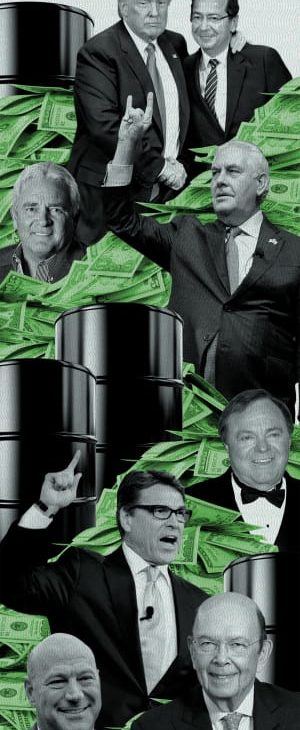Trump and Friends Cash In.

 Trump and Friends Cash In
Trump and Friends Cash In
Members and backers of the Trump administration are profiting from completion of the Dakota Access Pipeline while planning for an even larger payout from shipping oil and petrochemicals overseas.
Antonia Juhasz
Sep 12, 2018
A version of this story originally appeared in the September/October 2018 issue of Pacific Standard as a sidebar to “Death on the Dakota Access.”
The Producer: Harold Hamm, Chairman and CEO, Continental Resources
“Fracking King” Harold Hamm, dubbed Trump’s “energy whisperer” for his oversized role influencing the candidate’s energy policy, was a regular Trump sidekick at oil-country appearances pre- and post-election. Hamm donated personally to Trump’s presidential bid, while Continental Resources ponied up $100,000 for the inauguration. After the Dakota Access Pipeline’s (DAPL) completion, Continental’s Bakken oil production surged, rising 58 percent between the last quarters of 2016 and 2017 and nearly 50 percent between March of 2017 and March of 2018. Hamm credited DAPL with enabling a nearly $5 per barrel reduction in Continental’s overall cost of oil it produces. A net income loss of $400 million in 2016 rose to a $789 million gain in 2017; stock value skyrocketed. Then, in January of 2018, Hamm personally donated $500,000 to Trump-backed super PAC America First Action.
The Middlemen: Kelcy Warren, Chairman and CEO, Energy Transfer Partners
Rick Perry, Secretary of Energy
Warren donated $100,000 to Trump’s joint fundraising committee after backing former Texas Governor Rick Perry for president via a $5 million gift to a pro-Perry super PAC. Former Dancing With the Stars contestant Perry served on Energy Transfer’s board from 2015 until January of 2017, when he was named secretary of energy. As secretary he’s advocated for faster pipeline permitting, increased oil and gas production and exports, and reduced regulation. The stock value of Energy Transfer Equity (owner of Energy Transfer Partners), in free fall pre-Trump, more than tripled between February of 2016 and May of 2018.
The Player: Wilbur Ross, Secretary of Commerce
Called the “king of bankruptcy” by Forbes, and elsewhere as “one of the best bottom feeders in the business,” Ross helped bail out Trump’s Taj Mahal casino back in 1991. His company, W.L. Ross & Co., moved into shipping in 2011—specifically tankers for petroleum and refined petroleum and natural gas products, including petrochemicals—becoming the largest shareholder of Diamond S Shipping and Navigator Holdings (Ross served on both boards for a time). In 2016, Ross went big into oil and gas, spending several hundred million dollars on debt-strapped companies. Diamond S and Navigator are cashing in on abundant and cheap “surplus” U.S. oil and natural gas flowing via pipeline to the coasts, from where they are shipping the bounty abroad. Navigator’s fate is particularly tied to that of Energy Transfer Partners, as it hopes to ship oil and gas products (particularly petrochemicals) from ETP export terminals in Pennsylvania and Texas. In his January of 2017 confirmation hearing, Ross said he’d resigned from W.L. Ross & Co., but refused to divest from Diamond S. The Paradise Papers later revealed his continued Navigator holdings as well. Then, after a Department of Commerce spokesman stated that Ross had divested both his Diamond S and Navigator holdings, Forbes found that Ross had likely simply shifted the former into a family trust.
The Wolf in Sheep’s Clothing: Rex Tillerson, Former CEO, ExxonMobil, Former Secretary of State
ExxonMobil’s already significant Bakken operations caused it to be named one of DAPL’s likely financial beneficiaries by investment website Seeking Alpha, and, in February of 2018, ExxonMobil told investors that it plans to increase its Bakken production by 50 percent—oil that will surely come in handy as the company begins a planned $20 billion expansion of its petrochemical refining capacity along the Gulf Coast, with several new facilities planned or coming online this year. ExxonMobil reported $5.9 billion in immediate tax savings as a result of the Tax Cuts and Jobs Act, the highest oil-industry payout. Tillerson was barred from deriving financial gain from ExxonMobil holdings while secretary of state, but upon his firing in March of 2018, he was once again allowed to invest freely in his former company.
The Facilitator: John Paulson, President and Portfolio Manager, Paulson & Co., Inc.
One of the first people on Wall Street to back Trump for president, Paulson served as a campaign economic adviser and a $250,000 contributor to Trump’s inaugural committee. Dubbed a “hedge-fund titan,” his oil and gas investments have included Oasis Petroleum, also named one of the likely biggest beneficiaries of DAPL by Seeking Alpha due to its large Bakken holdings. Oasis Midstream Services, MLP, owned by Oasis Petroleum, built pipelines that deliver oil to DAPL. Goldman Sachs is part owner of Oasis Petroleum.
The Financier: Gary Cohn, Former President and CEO, Goldman Sachs Group, Former National Economic Council Director and Chief Economic Adviser to Trump
At Goldman, Gary Cohn helped define how modern banks make billions off energy, particularly oil. Called “a hedge fund in drag,” Goldman has co-owned oil and gas pipelines (including the Kinder Morgan pipeline company), thousands of wells, and even a refinery in Kansas. From 2015 to 2017, Goldman provided hundreds of millions of dollars in financing to DAPL partners and parent companies. Cohn entered the White House in January of 2017, and, by April of 2018, Goldman’s net income shot up by nearly 30 percent over the previous year. Cohn’s landmark achievement, the Tax Cuts and Jobs Act, doled out billions of dollars to the nation’s largest banks, oil companies (see Pacific Standard’s original analysis of how the law benefited DAPL companies directly), and members of the 1 percent (including Cohn and Trump).
The Dealmaker: Donald Trump, President of the United States
One of Trump’s first orders of business upon entering office was a presidential memorandum clearing the way for DAPL completion, signed on January 24th, 2017. In his 2015 financial disclosure, Trump had reported between $3 million and $15 million invested in Paulson’s hedge funds; between $25 million and $50 million in a BlackRock pooled investment fund (BlackRock has invested billions in oil and gas); between $500,000 and $1 million invested in both Energy Transfer Partners and Phillips 66 (which owns 25 percent of DAPL); and between $50,001 and $100,000 in ExxonMobil and EOG Resources (a leading Bakken producer), as well as many other oil companies. In his 2016 disclosure, Trump reported reduced holdings in Energy Transfer Partners and Phillips 66; he then reported selling all of his shares in all companies in June of 2016, though no evidence of that has ever been made public, and he made no comment on the status of his hedge-fund investments.
By Antonia Juhasz
Antonia Juhasz reported from Standing Rock for Pacific Standard. She is the author of three books, most recently, Black Tide: The Devastating Impact of the Gulf Oil Spill. She lives in San Francisco.
